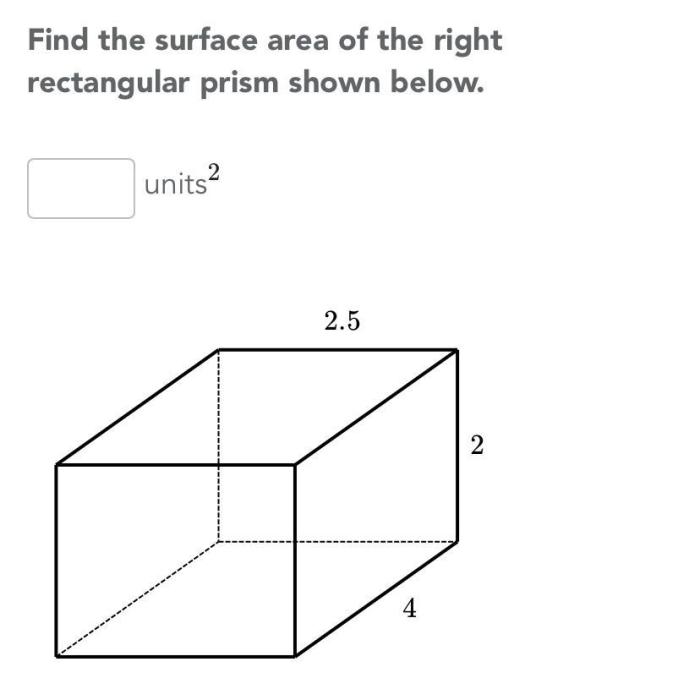Surface area of a rectangular prism answer key: Embark on an enlightening journey into the world of rectangular prisms, where we unravel the mysteries of their surface area. This comprehensive guide will equip you with the knowledge and techniques to master the calculation and optimization of surface area, unlocking a treasure trove of applications in diverse fields.
Delve into the intricacies of surface area, exploring its significance in engineering, architecture, and manufacturing. Discover how surface area influences the functionality and design of everyday objects, from towering skyscrapers to sleek automobiles.
Surface Area of a Rectangular Prism
The surface area of a rectangular prism is the sum of the areas of all its faces. It is measured in square units, such as square centimeters or square meters. The formula for calculating the surface area of a rectangular prism is:
Surface Area = 2(lw + wh + lh)
where l is the length, w is the width, and h is the height of the prism.
For example, the surface area of a rectangular prism with a length of 5 cm, a width of 3 cm, and a height of 2 cm is:
Surface Area = 2(5 cm x 3 cm + 5 cm x 2 cm + 3 cm x 2 cm) = 54 cm 2
Applications of Surface Area
Surface area has numerous applications in real-world scenarios. In engineering, surface area is used to calculate the amount of heat transfer between an object and its surroundings. In architecture, surface area is used to determine the amount of paint or other materials needed to cover a building.
In manufacturing, surface area is used to calculate the amount of material needed to produce a product.
For example, the surface area of a car is used to determine the amount of paint needed to cover it. The surface area of a solar panel is used to calculate the amount of sunlight that can be converted into electricity.
Factors Affecting Surface Area: Surface Area Of A Rectangular Prism Answer Key

The surface area of a rectangular prism is affected by three factors: length, width, and height. Increasing any of these dimensions will increase the surface area.
For example, if the length of a rectangular prism is doubled, the surface area will also double. If the width of a rectangular prism is tripled, the surface area will also triple.
Surface Area Optimization
Surface area optimization is the process of finding the dimensions of a rectangular prism that will give it the maximum surface area for a given volume. This is important in applications where the surface area is a critical factor, such as in heat transfer or solar energy.
One technique for surface area optimization is to make the prism as close to a cube as possible. This is because a cube has the maximum surface area for a given volume.
Question Bank
What is the formula for calculating the surface area of a rectangular prism?
The formula for calculating the surface area of a rectangular prism is: Surface Area = 2(lw + lh + wh), where l is the length, w is the width, and h is the height.
How does surface area affect the design of objects?
Surface area plays a crucial role in the design of objects. For instance, in architecture, the surface area of a building’s exterior walls influences the amount of heat transfer, affecting the building’s energy efficiency.
Can surface area be optimized?
Yes, surface area can be optimized by adjusting the dimensions of the rectangular prism. By manipulating the length, width, and height, it is possible to achieve a desired surface area while meeting specific constraints.